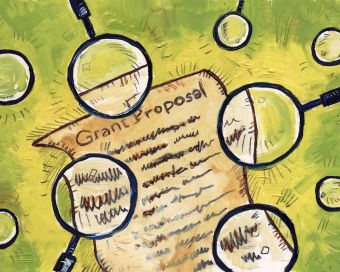The National Science Foundation is making changes in its submission process that will affect grant proposals turned in on or after January 14. The changes are not earth-shattering, but you won't be able to submit your proposal online if you don't follow the new rules.
Following are some key changes in the NSF's Proposal and Award Policies and Procedures Guide (you can read it in its entirety here). The foundation received nearly 49,000 proposals in fiscal year 2011-12 and awarded money to 24 percent of them. Don't become part of the 76 percent simply because you weren't aware of the new rules.
Project summary. The project-summary portion of a grant proposal has always required an overview, including discussion of the "intellectual merit" and "broader impacts" of the proposed work. You used to submit the summary as a single one-page document. Now, although the summary is still limited to a page (4,600 characters, to be exact), you must provide the information in three separate text boxes—one for a project overview and one each for statements on the intellectual merit and the broader impacts of your project. The 4,600 characters can be divided among the three text boxes however you see fit.
If you don't do that correctly, the NSF FastLane submission portal won't accept your proposal. The purpose of the change is to save program officers many hours of poring over project summaries to ensure that the information requested in those sections has been included.
There is an exception: Because researchers in mathematics and physics need to use special characters that the text boxes cannot accommodate, they may submit the summary as a supplementary document. But they may not submit summaries in both formats as a way to gain more space for that section of the proposal.
Researchers come up with endless ways to wiggle around an agency's proposal requirements, and the NSF has anticipated some of them with regard to the new project summary. If your proposal is due on or after January 14, but you submit it before then, you must still follow the new format for the project summary.
If you prepare your proposal before January 14 but submit it on or after that date and don't divide your summary among the three text boxes, FastLane will insert all of your project-summary text into the overview text box. Nothing will appear in the intellectual-merit and broader-impacts boxes, and your proposal won't be accepted. In case you are still mulling ways to avoid this change, you won't be able to do so by submitting your proposal through the Grants.gov portal instead of the FastLane portal.
Review criteria. The NSF will continue to use two review criteria to evaluate proposals: intellectual merit and broader impacts. However, the broader-impacts criterion has been a source of confusion for many researchers, so the National Science Board, which oversees the foundation, has provided additional guidance by spelling out just what constitutes a broader impact. Some researchers privately scorn the broader-impacts criterion as an unwelcome distraction from their science.
What they may not realize is that this pesky requirement comes from the hand that feeds, so it is in their best interest not to bite it. That hand, of course, belongs to Congress.
The broader-impacts criterion is required by Congress and spelled out in the law that authorizes funds for the foundation. The law states that the government is investing in scientific research to improve the competitiveness of the United States. Thus, when making grants, the NSF must keep in mind these goals: increased economic competitiveness; development of a globally competitive work force in science, technology, engineering, and mathematics; increased participation of women and members of underrepresented minority groups in these fields; improved education and teacher development in these fields in elementary and secondary schools; improved undergraduate education in these fields; increased partnerships between academe and industry; increased public scientific literacy; and increased national security.
The take-home message is that Congress is not solely interested in financing the progress of basic science: It wants to invest in activities that will enhance the nation's position in the global economy. Even if you think that is shortsighted, understanding that perspective will help you as you try to incorporate broader impacts into your project.
In a recent presentation, the NSF made it clear that the National Science Board does not expect anyone to accomplish all of these goals in a typical three-year, $300,000 grant. Rather, applicants should strive for impact that is in proportion to the size of the project. The agency's total grant portfolio should reflect progress toward achieving the societal goals identified by Congress.
As an aside, the agency will remove from its Web site the current list of examples of activities that meet the broader-impacts criterion. Officials say the list caused confusion, with some applicants thinking the examples were the only activities that were considered broader impacts, rather than just guidance.
Biosketch. The biosketch portion of a submission to the NSF has allowed the applicant to list five publications closely related to the proposed project and five other significant publications. The new rules ask for products instead of publications, to reflect the changing nature of scientific work.
Products can include, but are not limited to, patents, data sets, software, and copyrights. If your field has a citation style for describing those products, use it. If not, list them in a way that will allow a reviewer to locate them if he or she so chooses. Unacceptable products—i.e., things you shouldn't bother listing—would include unpublished articles and invited lectures.
Facilities, equipment, and other resources. The NSF does not normally provide salary support during the academic year; it considers research part of a faculty member's normal duties, covered by salary from the institution that employs him or her. If a principal investigator will receive no salary from a grant, the investigator's name should not appear in the proposal's budget. Rather, the investigator's contribution to the project should be discussed in the facilities form. (The investigator's name can also appear on the cover sheet.)
Don't attach a dollar figure to anything discussed in the facilities section. Detailed financial information could be interpreted as voluntary cost sharing, which is not permitted in NSF grants. If for some reason you have no facilities, equipment, or resources to describe, write a brief statement to that effect on the form. Eventually (probably this spring) FastLane will not accept your proposal if you leave the facilities section blank.
Pay attention. Program announcements will be revised throughout the year to reflect changes in the proposal preparation guide, so be sure to read each thoroughly, even if you have applied to that particular program before.
The slides and audio from a recent NSF presentation on these changes are available here. Researchers with questions about the new procedures can submit them to policy@nsf.gov.










